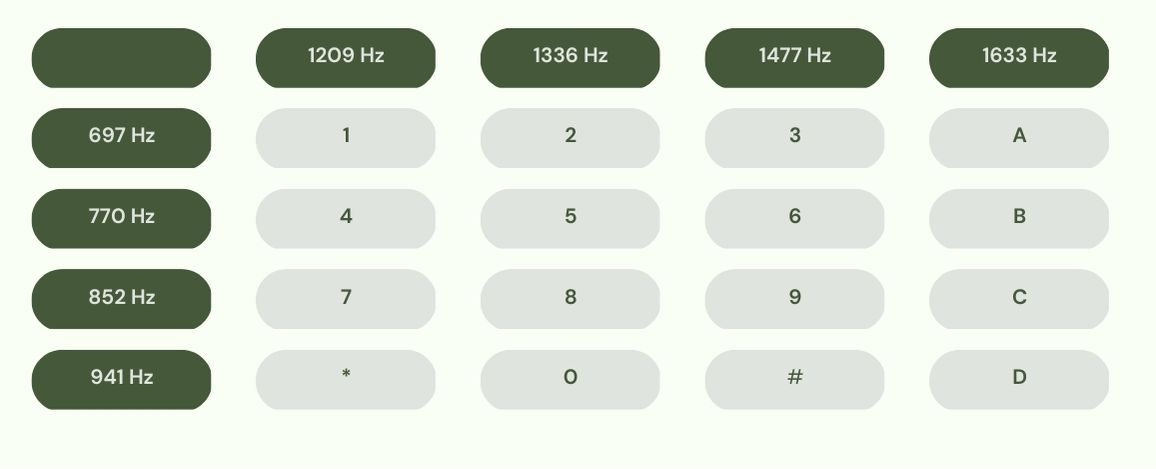Hacking Google
Hackable Audio
Hacking Google is simultaneously an urgent PSA, notifying us about the myriad ways we are vulnerable online, and a way to engage with budding “ethical hackers." The Creative Lab wove puzzles into the Hacking Google series, offering prizes to the first teams or individuals to complete the puzzles. Antfood was also given a special task: Incorporate hidden messages into the soundtrack in unconventional ways. Game on!
Our Approach
Antfood was excited to connect with the audience on a deeper level than usual. The practice of encoding secret messages within music is not a new phenomenon, but with audio technology improving and becoming more accessible by the day, we have more opportunities to drop surprise-and-delight moments into our music and audio. This allows us to convey more than what is initially audible in our score, to treat our most engaged listeners to unexpected easter eggs, and to send literal messages that lyric-less music often cannot.
Dual-Tone Multi-Frequency
Hacking Google delves into the early days of the internet and the tech of that era, including landline phones. Phones use a consistent language for dial tones: dual-tone multi-frequency.
When you press 1 on a dial pad, the phone simultaneously plays out 697 Hz and 1209 Hz, resulting in the sound we’re all familiar with.

Dial Pad Dual Tone Multi Frequency Combinations
This language is employed globally, so when a dial tone sound effect was needed in Episode 0, we hid a phone number in the sound design. It was discernible and translatable by anyone with a functioning phone. The audio clue led viewers to a toll-free number, which, when called, revealed the next step in the puzzle.
Musical Cryptography
Google asked us to hide the password “One Hook” – a theme that surfaces in the series – in Episode 2 using musical cryptography.
Musical cryptography is encoding messages with the notes of a song. It can be traced back to the 1600s, as a technique that Bach would employ to cheekily sign his name in compositions.
Inspired by the history of cryptography in Western classical music, we aimed to encode messages into the notes of our compositions in a way that connects to the subject of the film while being decipherable by non-musicians.

The Bach Motif
The system we crafted was QWERTY Pentatonic. We took notes from the D minor pentatonic scale, assigning them to keys as oriented on a traditional QWERTY keyboard, in ascending order starting on Q.
Byincorporating the computer keyboard as the mode of deciphering the hidden message, QWERTY Pentatonic has strong ties to the subject matter of Hacking Google.

Notes on a musical staff with their corresponding keys in QWERTY Pentatonic
Using the pentatonic scale as the source of our musical notes was beneficial for two primary reasons:
Flexibility
The scale is particularly consonant, meaning that each note generally sounds good when combined with other notes in the scale - so we didn't need to worry about any 'words' sounding bad.
Legibility
The scale is more spaced out than a traditional major or minor scale, with five notes per octave rather than seven. With more distance between notes, listeners can more easily distinguish between pitches in the scale.
Morse Code
We were tasked with hiding a URL in Morse Code within the series’ sound design.
Morse Code is not only a sound-based pattern language used around the globe, but it also provides interesting rhythmic possibilities with dots and dashes giving us short and long notes, respectively.
Each letter is denoted by multiple dots and dashes. For example, J is ᐧ — — —, which takes a lot of time to get through (1.4 seconds if we’re going by the book).
For just one letter, that is a lot of time investment, especially in the context of a series, so we divided the URL into six pieces and snuck a piece into the sound design of each episode after the opening titles.
Spectrogram
The most challenging and best concealed audio puzzle we created was a QR code, which could only be revealed by analyzing the audio track from Episode 2 through a spectrograph. A spectrogram (the image that a spectrograph produces after analyzing audio) functions in a similar way to infrared — but for sound — where a visual depiction of the frequency content of a signal indicates which sounds on the frequency spectrum are most intense.
We were inspired by some recent instances of hidden messages revealed through spectrograms in popular music and video games. For example, the soundtrack to the video game Doom encodes satanic messages in its score, which some astute listeners were able to spot.
We built a tool in Max MSP through which we could take an image and convert it into sound. With this tool, we encoded a QR code which, when revealed and scanned, would lead participants to the next step in their hunt.
There is one main challenge with encoding images through a spectrogram-to obtain a clear depiction, you need to use audio that is oftentimes non-musical and even abrasive to listen to. So instead of trying to weave a QR code into the musical score, we incorporated it into our sound design, using this particular moment to accompany a moment of scrolling on a screen and flickering numbers and symbols.
We embedded a secret sonic cue in this moment.
When viewed through a spectrogram, a QR code emerged.
Attention and Accolades:
Our work was honored with the Most Innovative Process & Execution at the 2023 AMP Awards for Music & Sound.
"Hacking Google is an example of collaboration at its best. It embodies the core of what we do at Antfood. With over 1.5 hours of original music, 75 original compositions and 3 arrangements of existing music, composed and arranged across three different continents we redefined the tropes of hacking music while evoking the empathy, humanity, and courage of the Google cybersecurity team."
- Trevor Haimes, Antfood Producer
Tags
Credits
Press & Awards
Most Innovative Process & Execution

